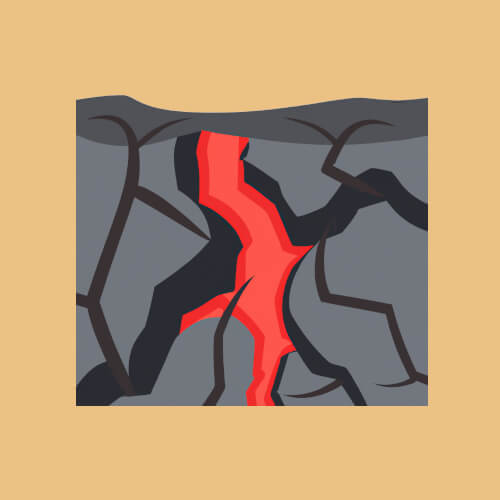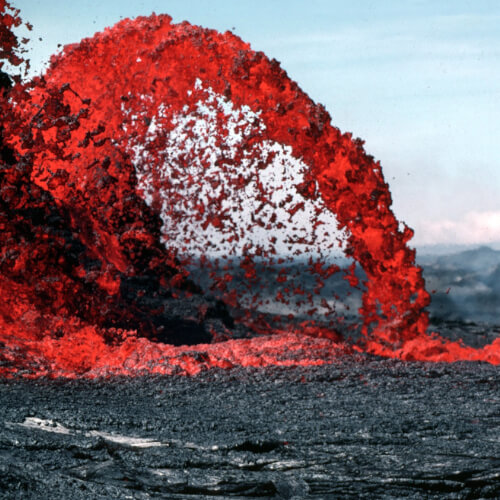



Lava is magma, or molten rock, that flows above Earth's surface, most commonly when a volcano erupts. It is a red-hot liquid made up of various minerals, gases, and volcanic debris. As volcanic activity intensifies, the pressure from beneath the Earth's surface forces the magma upward, leading to a spectacular display of lava flows and volcanic eruptions.
Lava comes in different types, each with its unique characteristics. Some lava flows gently, like a slow-moving river, while some explodes violently into the air, sending ash and rock fragments far and wide.
Scientists group lava flows into two main types:
Lava flows can be highly hazardous to both human populations and the environment. The intense temperatures and speed of flowing lava can engulf and destroy everything in its path, including buildings, forests, and roads. Volcanic eruptions often produce other dangerous phenomena as well, such as pyroclastic flows, volcanic gases, ashfall, and lahars (volcanic mudslides). These hazards can cause widespread devastation and pose significant risks to communities living near active volcanoes.
Despite these dangers, volcanic ash and debris deposited during eruptions can enrich the soil with nutrients, supporting diverse ecosystems and enhancing agricultural productivity in the long run. Volcanic gases released during eruptions can also influence climate patterns. For example, sulfur dioxide (SO2) can react with water vapor (H2) in the atmosphere to form sulfate aerosols, which can reflect sunlight and have a cooling effect on the Earth's surface.
To lower the risks associated with lava flows and volcanic eruptions, scientists and authorities closely monitor volcanic activity. They employ various techniques, including seismic monitoring, gas measurements, and satellite observations, to detect signs of volcanic unrest and provide early warnings to at-risk populations.
Additionally, emergency preparedness plans are crucial for communities living near active volcanoes. These plans include evacuation procedures, the establishment of exclusion zones, and education on volcanic hazards and safety measures.
When lava flows into water like the ocean or a lake, it creates something called a "lava delta." The hot lava cools down quickly and forms a solid area in the water. Sometimes, the lava can explode and break into small pieces when it meets the water, creating steam and ash.
Lava deltas can stretch far into the water, but they can be unstable and collapse suddenly. These collapses can cause dangerous currents known as "lava delta collapses" or "lava delta tsunamis." It's essential to be careful around active lava flows near water to avoid any risks.
One interesting example of this is the creation of "lava trees" or "tree molds." When lava flows through a forest, it can cover the trees. As the lava cools and hardens around the trees, the trees burn away, leaving hollow spaces in the hardened lava that look like the shape of the trees.
Lava can also form fascinating structures called "lava tubes." Lava tubes are tunnel-like passages created when the outer layer of a lava flow cools and solidifies while the hot lava continues to flow inside. After the lava flow stops, the lava tube remains, creating unique underground passages. Some lava tubes can be very long, stretching for many kilometers, and people have used them for shelter and exploration throughout history.
Lava rocks, or volcanic rocks, are lightweight and come in various interesting shapes, making them popular for decorating gardens and yards. They are well-known in landscaping for their ability to soak up and retain heat. Lava rocks warm up during the day, and slowly release this heat at night, which helps plants in dry or desert areas stay cozy on chilly nights.
Lava rocks are also often used as a natural option in gas grills and fire pits instead of artificial briquettes or logs. They resist heat well and spread it evenly, making them a great option for these uses.
While most lava flows are slow-moving and can be easily avoided, some types of lava, such as pahoehoe, can exhibit surprising speeds, reaching velocities of up to 10-30 kph (6-19 mph). For reference, Usain Bolt, the fastest sprinter in human history, reached a top speed of about 44 kph (27.3 mph) during the Olympic games. The speed of a lava flow is a result of the lava's chemical makeup, its viscosity (thickness), its temperature, and the force of gravity acting on it.